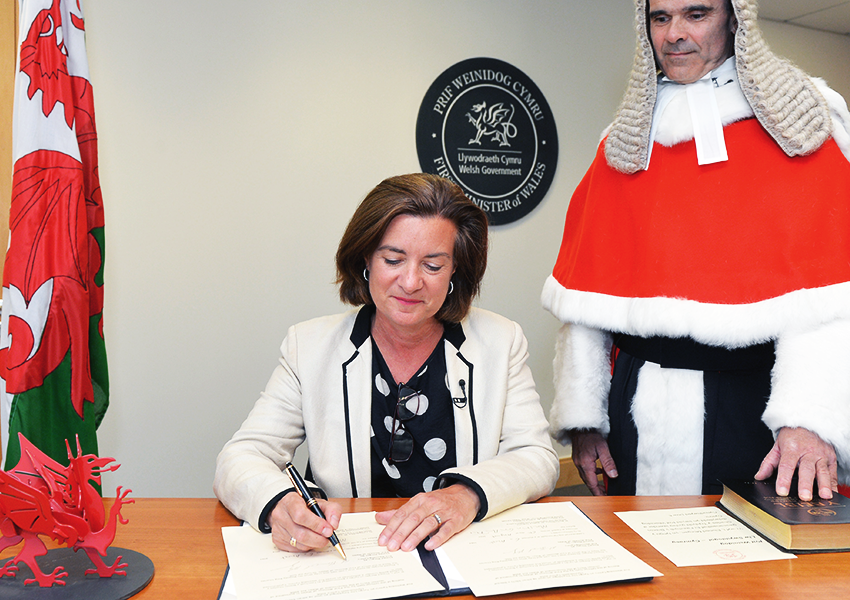Since the start of the devolution process 25 years ago, the position of First Minister of Wales has always been occupied by the leader of the Welsh Labour party.
Because the Welsh Government has never been led by any party other than Labour (although other parties have shared power in coalitions and other forms of cooperation), Wales has never changed its First Minister – the head of the Welsh Government – immediately after an election.
Instead, first ministers have always changed mid-term, or in other words, between elections.
Usually, a change of first minister happens when the previous incumbent has indicated their intention to resign. Following that announcement, the incumbent’s party will have gone through its own process to elect its new leader.
Once the identity of that new leader is known, the formal process of nominating a new First Minister of Wales can begin.
During the week of the changeover, the incumbent would normally lead one final Cabinet meeting and take part in a final session of First Minister’s Questions in the Senedd Siambr.
There would also be an opportunity for the outgoing First Minister to make a resignation statement. In that statement, they may recount some of their successes while in office, give thanks to those who have supported them, and receive best wishes from the leaders of other parties.
For example, when Mark Drakeford resigned as First Minister in 2024, he spoke about the political – and personal – events of the previous few years, including the COVID-19 pandemic, and also shared a number of funny anecdotes from his time in public service. He received a standing ovation from all four parties represented in the Senedd.
Later, normally the same day, the outgoing First Minister would submit a formal letter of resignation to the King, which the King would accept.
Following their resignation, the Senedd has 28 days to nominate a successor, although in practice this happens much more quickly.
Once the Senedd has been notified [i] of the First Minister’s resignation, the Llywydd, who presides over proceedings in the Senedd and is the equivalent of the Speaker of the House of Commons, will invite nominations for the office of First Minister.
This is different to how things work in Westminster. There, the Prime Minister doesn’t need to be nominated. They are just appointed by the King under the Royal Prerogative on the basis that they lead the party or grouping which can command the confidence of the House of Commons.
In Wales, in theory, any Member of the Senedd could be nominated to be First Minister [ii]. In practice, though, because the Senedd’s nominee has to have a simple majority of support, this would normally be (and has always been) the leader of the largest political group in the Senedd, i.e. Labour.
So, when the Llywydd invites nominations, name of the new leader of that party would be put forward. If that is the only name put forward, that person automatically becomes the Senedd’s nominee for the office of First Minister.
However, it is possible that other names might be put forward. For example, one or more of the other parties in the Senedd might put forward their leaders’ names. Doing this is largely symbolic, perhaps as a message to the governing party or to try and win policy concessions from the Welsh Government. It has happened a few times, but not every time.
But sometimes, symbolism can come close to actually happening. Following the 2016 election, when Labour won 29 seats, Plaid Cymru nominated their leader Leanne Wood for the office of First Minister.
The 29 voting members of the Plaid Cymru, Welsh Conservative, and UKIP groups voted for Wood, with Carwyn Jones also receiving 29 votes from Labour and the Liberal Democrat Kirsty Williams. The deadlock lasted a week before Labour and Plaid Cymru agreed to the formation of a minority Labour government.
Were such a scenario to arise again in the future, the process would be the same as in 2016. The Senedd would simply have to vote until one name has secured a simple majority of support. They may need to go through several rounds of voting until this is achieved.
If a nomination cannot be made within 28 days, a fresh Senedd election follows, so it’s generally a good idea to make a nomination.
Assuming that doesn’t happen, once one person has a simple majority of support, that person becomes the Senedd’s nominee for the office of First Minister, and addresses Members of the Senedd for the first time as First Minister-designate.
Then, the Llywydd will write to the King to inform him of the name of the Senedd’s nominee [iii]. Shortly afterwards, the King will formally appoint the new First Minister by a document called a Royal Warrant. The First Minister will become Keeper of the Welsh Seal at the same time [iv].

Once the Llywydd has informed the Welsh Government of the King’s approval, the new First Minister will take part in a simple ceremony, normally held either at the Welsh Government’s headquarters in Cathays Park or its offices in Cardiff Bay, where they take the Official Oath or make the equivalent Affirmation before a judge [v].
Then the business of governing begins. The First Minister will name ministers for the King’s approval, and the new Welsh Government will get to work.
In the following days and weeks, the First Minister would also be sworn of the Privy Council, if not already a member.




Rate and Review
Rate this article
Review this article
Log into OpenLearn to leave reviews and join in the conversation.
Article reviews